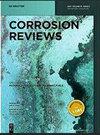HVOF沉积Zn-Ni-Cu和Zn-Ni-Cu - tib2涂层在低碳钢上的腐蚀行为
IF 3.2
4区 材料科学
Q3 ELECTROCHEMISTRY
引用次数: 3
摘要
摘要本研究采用高速氧燃料(HVOF)热喷涂技术在低碳钢基体上沉积Zn-Ni-Cu和Zn-Ni-Cu - tib2涂层。按照(ASTM B-117)标准进行的中性盐雾(NSS)腐蚀试验和按照ASTM G-31、ASTM G1-03标准进行的浸泡循环试验对镀Zn-Ni-Cu和镀Zn-Ni-Cu - tib2的低碳钢以及作为对照的未镀Zn-Ni-Cu的低碳钢进行了腐蚀试验。Zn-Ni-Cu和Zn-Ni-Cu - tib2涂层低碳钢都比未涂层的低碳钢耐腐蚀。浸没循环试验后的拉曼分析推断,未涂覆的低碳钢有各种形式的锈蚀。而Zn-Ni-Cu和Zn-Ni-Cu - tib2涂层的低碳钢几乎没有生锈。表征有助于了解测试前后表面的变化。结果表明:镀Zn-Ni-Cu和镀Zn-Ni-Cu - tib2涂层的低碳钢与未镀Zn-Ni-Cu - tib2涂层的低碳钢相比,表面腐蚀退化较小;这表明两种涂层在腐蚀性环境下的性能都明显优于未涂层的低碳钢。在3.5% NaCl介质中对涂层和未涂层的低碳钢进行极化和EIS测试,有助于了解涂层在频率范围内的行为。与未涂覆的低碳钢相比,两种涂层样品均具有较高的极化电位Ecorr值和较低的极化电流Icorr值。与未涂覆的低碳钢相比,涂层在腐蚀性环境中的性能更好。本文章由计算机程序翻译,如有差异,请以英文原文为准。
Corrosion behaviour OF HVOF deposited Zn–Ni–Cu and Zn–Ni–Cu–TiB2 coatings on mild steel
Abstract In this study, Zn–Ni–Cu and Zn–Ni–Cu–TiB2 coatings were deposited using high-velocity oxy-fuel (HVOF) thermal spray technique on a mild steel substrate. Corrosion tests like neutral salt spray (NSS) following (ASTM B-117) standard and immersion cycle test following ASTM G-31, ASTM G1-03, standards were carried out for Zn–Ni–Cu and Zn–Ni–Cu–TiB2 coated mild steel along with uncoated mild steel acting as a control. Both Zn–Ni–Cu and Zn–Ni–Cu–TiB2 coated mild steel were corrosion resistant as compared to uncoated mild steel. Raman analysis following the immersion cycle test inferred that uncoated mild steel had all forms of rust. While Zn–Ni–Cu and Zn–Ni–Cu–TiB2 coated mild steel developed very little rust. The characterization helped to understand the changes in the surface before and after tests. It was observed that both Zn–Ni–Cu and Zn–Ni–Cu–TiB2 coated mild steel had little corrosion degradation of surface as compared to uncoated mild steel. Suggesting that both coatings performed significantly better compared to uncoated mild steel in corrosive environments. Polarization and EIS tests of both coated and uncoated mild steel in a 3.5% NaCl medium helped to understand the behaviour of coatings over a range of frequencies. Both coated samples had high polarization potential Ecorr values and lower polarization current Icorr values as compared to uncoated mild steel. Inferring better performance of coatings in corrosive environments as compared to uncoated mild steel.
求助全文
通过发布文献求助,成功后即可免费获取论文全文。
去求助
来源期刊

Corrosion Reviews
工程技术-材料科学:膜
CiteScore
5.20
自引率
3.10%
发文量
44
审稿时长
4.5 months
期刊介绍:
Corrosion Reviews is an international bimonthly journal devoted to critical reviews and, to a lesser extent, outstanding original articles that are key to advancing the understanding and application of corrosion science and engineering in the service of society. Papers may be of a theoretical, experimental or practical nature, provided that they make a significant contribution to knowledge in the field.
 求助内容:
求助内容: 应助结果提醒方式:
应助结果提醒方式:


